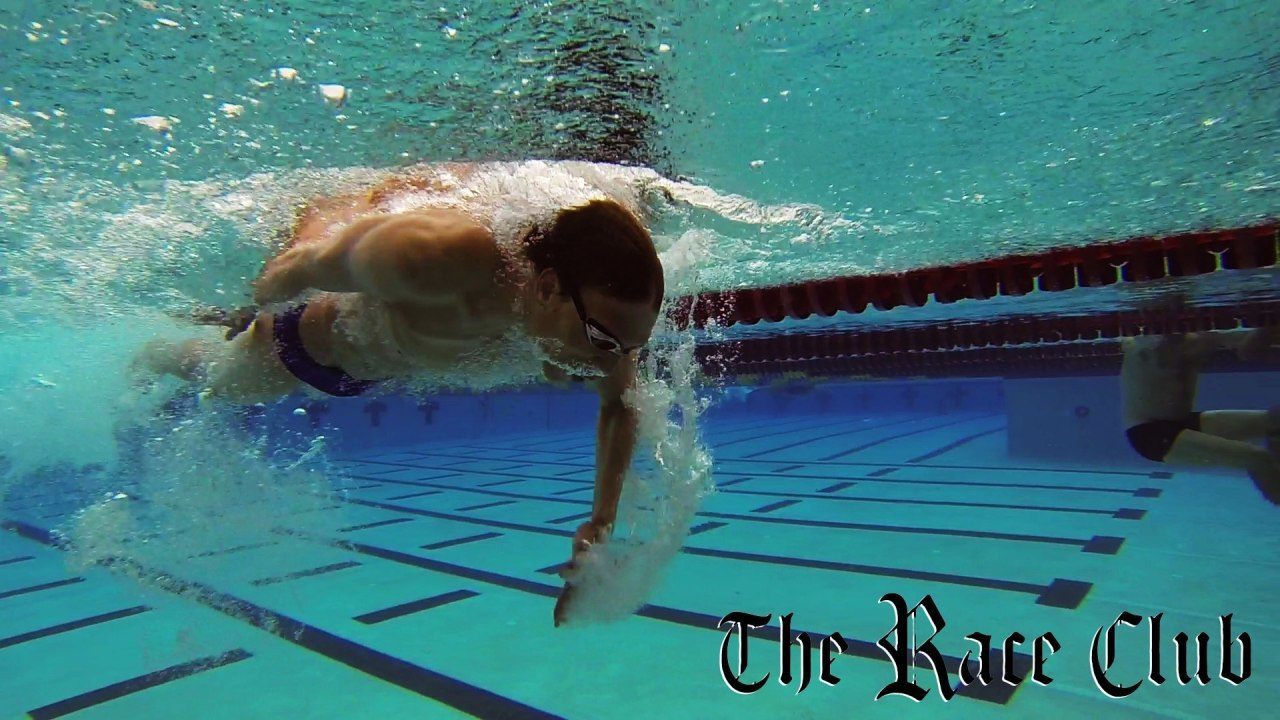Courtesy of Gary Hall Sr., 10-time World Record Holder, 3-time Olympian, 1976 Olympic Games US Flagbearer and The Race Club co-founder.
The important law of inertia comes into play at several key times during the flip turn and the approach to the wall is one of them. If a body in motion truly wants to stay in motion then the worst thing we can do is slow down while approaching the wall. Yet nearly every swimmer does.
Why swimmers slow down as they approach the wall
There are two primary reasons why swimmers tend to slow down as they approach the wall. The first is that they fail to keep swimming to the wall. Too often, swimmers will use the T on the end of the black line on the bottom of the pool, as if that is a queue to stop swimming, and glide until they feel it is time to make the flip. With the compelling frontal drag forces imposed by the water on a swimmer’s body during that glide time, they begin to slow down immediately. Their speed drops like it is falling off a cliff. In such a case, by the time the flip is initiated from a much slower speed, more work is required to get the legs over the top and on to the wall than if the swimmer had elected to take another stroke and maintain a higher speed. It also takes more time to get there. Even a partial stroke is better than none and a glide.
The second reason that swimmers slow down as they approach the wall is that they lift their heads up, usually to see the cross on the end of the pool, in order to judge the timing of their flip. Lifting the head up, whether swimming or gliding, causes an immediate increase in frontal drag with a resultant slowing down. Even worse, since the head needs to drop down under water in order to make the flip turn, lifting the head and arching the back is moving it in the wrong direction. While the head lift may create a little more downward force, since it drops down from a higher position, the energy required to get it there and the loss of speed are not worth the trade.
To look at the “T” or not to look at the “T” (on the bottom of the pool)
While keeping the head down going into the turn, utilizing the T on the bottom to judge the distance to the wall, may be faster, it also involves more risk for the swimmer. Without actually looking at the wall, there is a greater chance of being too far out or too close to the wall, once the flip is made. In either case, the penalty is greater than the reward. More time will be lost on the turn than if the swimmer looked up and nailed the wall.
The only effective way to prevent this problem is by practicing the “no look” turn over and over again, and by doing so at or close to race speed. With enough practice, a swimmer can learn to make the turn accurately at high speed and without looking straight ahead at the wall ahead. Or a compromise is to look at the bottom of the wall, rather than the cross, resulting in less head lift. The only exception is when the pool is extremely deep or with a deep-water bulkhead. In those situations, looking up is necessary. Otherwise, remember ‘fast in…fast out’. Keep the head down and swim to the wall.
Watch the video: http://www.theraceclub.com/videos/fast-swimming-techniques-freestyle-flip-turn-the-approach/
Read more about the Approach in the Freestyle Flip Turn: http://www.theraceclub.com/aqua-notes/flip-turn-part-approach/

Gary Hall, Sr., Technical Director and Head Coach of The Race Club (courtesy of TRC)
Yours in swimming,
Gary Sr.
https://www.facebook.com/theraceclub
http://instagram.com/theraceclub
https://twitter.com/theraceclub
https://www.linkedin.com/pub/gary-hall/9/908/671 [email protected]
<http://[email protected]
Www.theraceclub.com <http://Www.theraceclub.com
THE RACE CLUB
 Because Life is Worth Swimming, our mission is to promote swimming through sport, lifelong enjoyment, and good health benefits. Our objective is for each member of and each participant in The Race Club to improve his or her swimming performances, health, and self-esteem through our educational programs, services and creativity. We strive to help each member of The Race Club overcome challenges and reach his or her individual life goals.
Because Life is Worth Swimming, our mission is to promote swimming through sport, lifelong enjoyment, and good health benefits. Our objective is for each member of and each participant in The Race Club to improve his or her swimming performances, health, and self-esteem through our educational programs, services and creativity. We strive to help each member of The Race Club overcome challenges and reach his or her individual life goals.
The Race Club provides facilities, coaching, training, technical instruction, video, fitness and health programs for swimmers of all ages and abilities. Race Club swim camps are designed and tailored to satisfy each swimmer’s needs, whether one is trying to reach the Olympic Games or simply improve one’s fitness. Our programs are suitable for beginner swimmers, pleasure swimmers, fitness swimmers, USA swimming or YMCA swimmers, or triathletes; anyone who wants to improve swimming skills. All of our Race Club members share an enjoyment of being in the water and use swimming to stimulate a more active mind and body.

Great discussion. I have always encouraged my 2 swimming kids when younger that you have to drive into the wall at turns and at finishes – often a win comes down to who hit the wall (literally) first! Thanks for the break-down!
Thanks for the article. I taught myself to swim after deciding to start into the world of triathlon. The one thing I never bothered to learn was flip turns, telling myself I’d always get to it later. Well, it’s 10 years later and I still don’t do them. I’d really like to spend some time nailing them and appreciate the video series, but wondered if you have a specific drill sequence to make logical progression for someone starting from scratch.
Great article – I’d be interested in hearing more on how to gauge distance from a bulkhead.
Gary (or anyone else)–question:
Article says to minimize glide, and that ‘even a partial stroke is better than none and a glide.’ But I’ve consistently had troubles with kids taking (in my mind) unnecessary short strokes before the turn and being too close to the wall. Any advice on how to split the difference between too long a glide and unnecessary short strokes at the wall? Thanks!
This got pretty long, sorry. The short answer is that, if you teach your swimmers the right tricks regarding the catch and anchor of the hand, and they learn to judge their approach properly, they should never have to short-stroke it, with the possible exception of 50 freestylers or swimmers with a shoulder driven opposition stroke.. I tried to stay on topic, but some of this may be a bit beyond the scope of your question. I’m also not sure what your background/experience is, so if this comes across as super long winded, I apologize, but I tried to hit it from every angle.
This is a bit hard to explain without video/image support, but I’ll do my best to… Read more »
Thanks so much! Very helpful and not too long in the slightest. I appreciate it.
Sven did a nice job of responding to the question. A hip driven freestyler spends more time in the front (lift phase) of the pull and should have a stronger kick (in theory) going into the wall. He/she has the option of initiating the pull sooner in order to make the turn, if necessary. The shoulder driven freestyler really doesn’t have that option, since he/she is driving the hand back as fast as possible. For those swimmers, I believe it is best to continue with the high stroke rate all the way to the flip, rather than gliding to the wall. even if it means taking a short stroke. Maintaining that speed is dependent on the high stroke rate.
i think our club’s biggest issue with proper turn (any turn) performance is that it is almost impossible when there is a large group of kids circle swimming. They end up turning in a meet like they do in practice with head up so they won’t hit the guy ahead or behind, push off on an angle, etc.
You are absolutely right. Crowded lanes tend to induce bad habits on flip turns. I always recommend leaving 10 seconds apart to minimize the concern of the crowdedness. Even so, it is not ideal. So the best solution is to take the time to do some fast turns starting in the middle of the pool. You can have one group going in each direction and finishing with 2-3 strokes after the breakout. Have them race against one another….but only one swimmer per half lane at a time. That way, they practice at race speed and the competition will help them pay more attention to the details.
Gary I just showed a group of very good college swimmers your analysis if the freestyle flip turn. I have been frustrated over the years with the sloppy, non disciplined , turns done in practice, which carry over into meets. The same applies to fly and breaststroke turns not being setup fron the cross. Thanks.